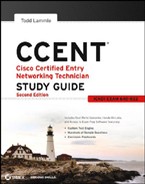Summary
Whew! I know this seemed like the chapter that wouldn't end, but it did—and you made it through! You're now armed with a ton of fundamental information; you're ready to build upon it and are well on your way to certification.
I started by discussing simple, basic networking and the differences between collision and broadcast domains. I also discussed the various devices used in an internetwork.
I then discussed the OSI model—the seven-layer model used to help application developers design applications that can run on any type of system or network. Each layer has its special jobs and select responsibilities within the model to ensure that solid, effective communications do, in fact, occur. I provided you with complete details of each layer and discussed how Cisco views the specifications of the OSI model.
In addition, each layer in the OSI model specifies different types of devices. I described the different devices, cables, and connectors used at each layer. Remember that hubs are Physical layer devices and repeat the digital signal to all segments except the one from which it was received. Switches segment the network using hardware addresses and break up collision domains. Routers break up broadcast domains (and collision domains) and use logical addressing to send packets through an internetwork.
We are now going to move on to IP addressing in the next chapter.
